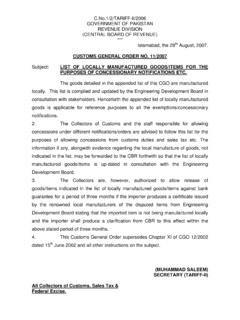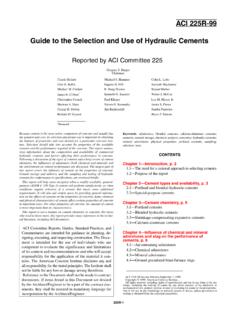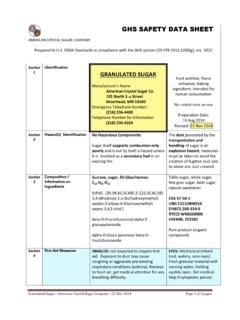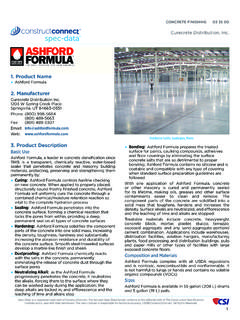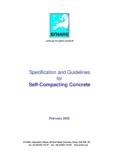Transcription of “Ground Granulated Blast Slag (GGBS) In Concrete – A Review”
1 IOSR Journal of Mechanical and Civil Engineering (IOSR-JMCE) e-ISSN: 2278-1684,p-ISSN: 2320-334X, Volume 12, Issue 4 Ver. VI (Jul. - Aug. 2015), PP 76-82 DOI: 76 | Page Ground Granulated Blast Slag (GGBS) In Concrete A Review D. Suresh1 and K. Nagaraju2 1 Assistant professor, Civil Engineering Department, Kuppam Engineering College, Kuppam. Chittoor district, Andhra Pradesh, India-517425 2 Assistant professor, Civil Engineering Department, Kuppam Engineering College, Kuppam. Chittoor district, Andhra Pradesh, India-517425 Abstract: Concrete is a mixture of cement, fine aggregate, coarse aggregate and water. Concrete plays a vital role in the development of infrastructure Viz.
2 , buildings, industrial structures, bridges and highways etc. leading to utilization of large quantity of Concrete . On the other side, cost of Concrete is attributed to the cost of its ingredients which is scarce and expensive, this leading to usage of economically alternative materials in its production. This requirement is drawn the attention of investigators to explore new replacements of ingredients of Concrete . The present technical report focuses on investigating characteristics of Concrete with partial replacement of cement with Ground Granulated Blast furnace Slag (GGBS). The topic deals with the usage of GGBS and advantages as well as disadvantages in using it in Concrete .
3 This usage of GGBS serves as replacement to already depleting conventional building materials and the recent years and also as being a by product it serves as an Eco Friendly way of utilizing the product without dumping it on ground. Keywords: GGBS, GGBS in Concrete , other materials with GGBS. I. Introduction General: Ground Granulated Blast furnace Slag (GGBS) [1] is a by product from the Blast furnaces used to make iron. These operate at a temperature of about 1500 degrees centigrade and are fed with a carefully controlled mixture of iron ore, coke and limestone. The iron ore is reduced to iron and the remaining materials from a slag that floats on top of the iron. This slag is periodically tapped off as a molten liquid and if it is to be used for the manufacture of GGBS it has to be rapidly quenched in large volumes of water.
4 The quenching optimises the cementitious properties and produces granules similar to coarse sand. This Granulated slag is then dried and ground to a fine powder. Although normally designated as GGBS in the UK, it can also be referred to as GGBS or Slag cement Concrete is basically a mix of fine aggregate, coarse aggregate and cement. The main problem is the original conventional materials are depleting and we are in hunt for alternate building materials which lands us here on the purpose of GGBS. Being a by product and waste using it effectively up to some extent serves as a step for a greener environment and at the same time keeping in mind that the strength of the Concrete doesn t degrade by the usage GGBS.
5 Fig 1: Sources of Ground Granulated Blast Slag Ground Granulated Blast Slag (GGBS) In Concrete A Review DOI: 77 | Page (Furnaces from Steel plants) Effectively concentrating on both the factors have been successful up to a good extent and that s what we CIVIL ENGINEERS are very keen about in the present era of construction. II. Chemical Composition Of GGBS The chemical composition of a slag varies considerably depending on the composition of the raw materials in the iron production process. Silicate and aluminate impurities from the ore and coke are combined in the Blast furnace with a flux which lowers the viscosity of the slag.
6 In the case of pig iron production the flux consists mostly of a mixture of limestone and forsterite or in some cases dolomite. In the Blast furnace the slag floats on top of the iron and is decanted for separation. Typical chemical composition: Calcium oxide = 40% Silica = 35% Alumina = 13% Magnesia = 8% The glass content of slag s suitable for blending with Portland cement typically varies between 90-100% and depends on the cooling method and the temperature at which cooling is initiated. The glass structure of the quenched glass largely depends on the proportions of network-forming elements such as si and Al over network-modifiers such as Ca, Mg and to a lesser extent Al.
7 Increased amounts of network-modifiers lead to higher degrees of network DE polymerization and reactivity. It is a granular product with very limited crystal formation, is highly cementitious in nature and, ground to cement fineness, and hydrates like Portland cement. Typical physical properties:- Colour : off white Specific gravity : Bulk density : 1200 Kg/m3 Fineness : 350 m2/kg III. Applications And Uses Of GGBS GGBS is used to make durable Concrete structures in combination with ordinary Portland cement and/or other pozzolanic materials. GGBS has been widely used in Europe, and increasingly in the United States and in Asia (particularly in Japan and Singapore) for its superiority in Concrete durability, extending the lifespan of buildings from fifty years to a hundred years.
8 Two major uses of GGBS [2] are in the production of quality-improved slag cement, namely Portland Blast furnace cement (PBFC) and high-slag Blast -furnace cement (HSBFC), with GGBS content ranging typically from 30 to 70% and in the production of ready-mixed or site-batched durable Concrete . Concrete made with GGBS cement sets more slowly than Concrete made with ordinary Portland cement, depending on the amount of GGBS in the cementitious material, but also continues to gain strength over a longer period in production conditions. This results in lower heat of hydration and lower temperature rises, and makes avoiding cold joints easier, but may also affect construction schedules where quick setting is required.
9 Uses Of GGBS The major use of GGBS is in ready mixed Concrete , and it is utilised in a third of all UK [2] ready-mix deliveries. Specifiers are well aware of the technical benefits, which GGBS imparts to Concrete , including: Better workability, making placing and compaction easier. Lower early age temperature rise, reducing the risk of thermal cracking in large pours. Elimination of the risk of damaging internal reactions such as ASR High resistance to chloride ingress, reducing the risk of reinforcement corrosion High resistance to attack by sulphate and other chemicals Considerable sustainability benefits. In the production of ready mixed Concrete , GGBS replaces a substantial portion of the normal Portland cement Concrete , generally about 50 %, but sometimes up to 70%.
10 The higher the portion, the better is the durability. The disadvantage of the higher replacement level is that early age strength development is somewhat slower. GGBS is also used in other forms of Concrete , including site-batched and precast. Unfortunately, it is not available for smaller-scale Concrete production because it can only be economically supplied in bulk. GGBS is not only used in Concrete and other applications include the in-situ stabilisation of soil. Ground Granulated Blast Slag (GGBS) In Concrete A Review DOI: 78 | Page GGBS is used as a direct replacement for Portland cement, on a one-to-one basis by weight.










